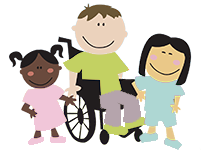How Can I Boost Communication Skills for My Child with Down Syndrome?
[vc_row][vc_column][vc_column_text]How Can I Boost Communication Skills for My Child with Down Syndrome?
Children with Down syndrome typically have moderate to severe speech and language delays. As a result, they will learn to speak at a slower rate than their same age typically developing peers. It is critically important to insure young children with Down syndrome have an annual speech and language evaluation and participate in individual speech therapy to address their specific treatment plan goals from an early age. Your pediatrician can refer you to an early intervention program if you child is under the age of 3 years. Speech & Occupational Therapy of North Texas also works with very young children and would be happy to talk with you regarding your child’s communication needs.
 Speech therapy is very important for toddlers with Down syndrome, and based on research, parents should partner with their speech-language pathologist to include recommended language practice throughout the day and in all typical settings. For this reason, our clinics utilize a partnership model, including parents for at least part of each therapy session.
Speech therapy is very important for toddlers with Down syndrome, and based on research, parents should partner with their speech-language pathologist to include recommended language practice throughout the day and in all typical settings. For this reason, our clinics utilize a partnership model, including parents for at least part of each therapy session.
This partnership also this means you pursue language enrichment at the grocery store, with extended family, at the park and any other public places that are a part of your life. For instance, if your family in involved in your local recreation center or a place of worship, work on communication in these natural settings.
For children with Down syndrome, there are three areas that need to be targeted: oral motor skills for speech; increasing single word vocabulary, and teaching how to combine this vocabulary into 2 word phrases. Children with Down syndrome begin to combine two words when they have a vocabulary of 50 to 100 words.
So in addition to speech therapy, what are some specific strategies parents can use to boost language development for their child with Down syndrome?
Label Life
Label and comment on functional, familiar and high interest objects and activities, keeping the phrases simple and concrete and related to what is happening in that moment. We learn meaning of words by hearing those words associated with an object. For someone with Down syndrome or for any child with IDD, they need more chances to pair the sounds in words with its observed meaning to establish vocabulary in working memory.
- Your teddy bear is on the chair
- You are drinking your juice. You like apple juice.
- The duck is yellow.
Read, Read, Read
There are many colorful picture books that will aid in teaching vocabulary and contextual concepts. Reading also helps a child learn simple grammatical forms. Books with repetition are great for encouraging a child to join in. Again, repetition will help with getting new words from the immediate to working memory. Think “Huff and puff and blow your house down!” Or “Run, run as fast as you can, you can’t catch me, I’m the gingerbread man”.
With stories, you can read them and see the action and in many situations, you can act out and experience the words. So you can help your child run as you say “run, run, as fast as you can” and then you practice “run, run as slow as you can”. You work on the concepts of run, fast, and slow this way.
Nursery rhymes are another great form for teaching language because of the repetition and rhyming often found in these old time favorites. “Hickory Dickory Dock, the mouse ran up the clock…” you can then find other clocks in the house, demonstrate a toy animal going up the couch or wall, and of course, be sure to find pictures of mice! Keep it simple and fun but reinforce meanings.
Arrange the Environment
Be sure you are providing a language rich setting for your child with Down syndrome. Sometimes we get so caught up in physical care and safety that we don’t provide the same toys, books and play opportunities for children with special needs that we would for typically developing toddlers. Have accessible items that will prompt your child to comment or request help. Keep some favored items out of reach so they need to request, even if it is through pointing, initially. I recall once teaching a young client with Down syndrome to request by lifting his arm and pointing his finger towards what I knew was his desired toy. After several trials with this, he pointed in that direction on his own!! Sometimes we have to start at the very beginning stages and highly motivating environments and toys help build a child’s internal motivation to communicate. What should you keep out of this environment? A TV that is constantly on. Within your environment, make sure you plan frequent times to comment on and interact with your child regarding whatever catches their interest. This leads to another important strategy:
Follow Your Child’s Lead and Be Responsive
Children retain more information and are more motivated to interact if communication focuses on their interests. So watch and join in! Respond to any initiations, even if it is a point towards an object or a one syllable utterance. Join in and label and comment, as we talked about before.
Provide Choices
Providing choices can be closely related to follow your child’s lead because you are becoming the expert on your child! You know they want the Duplo train, so you present this conveniently out of reach item with a less interesting toy and say “what do you want to play with? The Duplo train or the rabbit?” You are labeling, teaching the concept of making a choice, and also setting your child up to have a motivating activity around which you can communicate.
Imitate and Expand
Another important strategy is to repeat what your child says with the correct form. For example if they say “pu” when pointing to a puppy in a book, you can say “that’s right, pup!” You can then expand it to say “the pup is digging!” Adding that extra concrete information supported by the picture in the book is called expansion. Since children learn language by imitating, we expand on language they are using. Imitation and expansion is not correcting or expecting a child to repeat after us using the correct form. It is simply giving them an auditory example of the correct form. Repeating the targeted word throughout the activity will help the child get the correct form into their working memories. So finding ways to say “pup is digging” several times is good. Then perhaps you can then dig in the sandbox or a rice bin with your child. “We are digging!”
Praise and Positive Attention
Praising and acknowledging any communication attempt is very important. You need to be prepared to set aside what you are doing so you can focus on your child’s comments and requests as soon as possible. This praise and responsiveness from you will reinforce that communication works.
Encourage Social Language
Model and practice age appropriate pragmatic skills, such as waving bye and hi, acceptable personal space, turn- taking and sharing. Young children with Down syndrome may need help with understanding who they can hug and when they should keep an appropriate distance. It may need to be as concrete as listing who can be hugged with pictures of hugging and then stating we do not hug anyone else, and show related pictures.
Incorporating turn taking games frequently will help solidify the important concepts of waiting, and attending to others. Not only is turn taking important for successful play, it mimics the back and forth aspect of conversation.
You Can Help Your Child
Labeling, reading, arranging the environment, following your child’s lead, offering choices, imitating and expanding, providing praise and attention as well as encouraging social language are all strategies a parent or caregiver can incorporate into the day. You will find that you do many of these things naturally, but perhaps find you can become more intentional about increasing these opportunities. Particularly when you realize the great long-term benefits for your child!
We Would be Honored to Partner With You to Help Your Child
Speech & Occupational Therapy of North Texas has three family friendly clinics in Collin County. We provide speech therapy in Frisco, Plano and McKinney. Call our office if we can answer any questions or assist you in any way. We are network providers for many major insurance companies and work closely with area pediatricians.
For more great information about communication development and Down syndrome visit:
http://ajslp.pubs.asha.org/article.aspx?articleid=1757532
http://www.ndss.org/Resources/Therapies-Development/Early-Intervention/
https://www.researchgate.net/profile/Frances_Conners/publication/5935165[/vc_column_text][/vc_column][/vc_row]
